German construction worker Karl Rabitz, patenting his plaster grid, and did not mind thinking, how much later she will have applications. One of the most common - fence. Rabita grid, or just a chain, inexpensive, build a fence from the chain grid with their own hands is easy, and its operational qualities are very high. By the way, the "Rabita" has become nominated, and you need to treat this word for all Russian rules. Lovers from the Rabits are granted fences and curious, from the prior material, but quite reliable, and / or not deprived of artistic advantages:
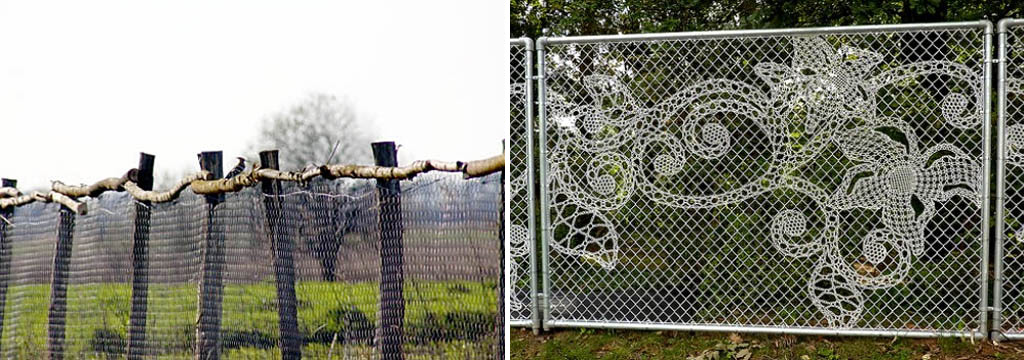
Make a fence from the Rabita without experience with 1-2 unqualified assistants around the plot of 20 acres can be in time for the weekend, not counting the gate C, if you know the features of this material and techniques for working with it. Their description is one of the objectives of this article. The second is to tell about some of the little-known useful qualities of fences from the Rabita, with which we and the commitment quickly, to close to do technique.
Note: Further, when describing the types of fences from the Rabita, we will be suggested how to make one or another without welding, if in this case it is generally possible. Dacha wiring most often simply will simply endure the working current of the welding machine, but to rent and carry the motor-generator is difficult and expensive.
What is good fence from the challenge?

First of all, - excellent viewing, high light and air permeability. It is impossible to flash down deaf fences, they shadow plants and disturb the circulation of surface layers of air, which aggravates the effect of frosts, Sukhovyev, etc. The fence from the welded grid also misses light, and the air, but its canvas is not voluminous. Spleasing spirals, of which the chain mesh is wound, divide the dense flow of air into small twists, which is why the wind energy drops and its action on buildings and plantings is reduced. The difference in aerodynamics is clearly visible in the ice (see fig. Right): The stronger the ice storm is stronger, the less skips his chapter. In general, for large periods of time (from 10 years), areas fenced with a slave, less suffering from the whims of the elements than the obscured by some other fence.
The volumetric structure of the Rabita gives it high elasticity in the stretched state. This is important primarily for playgrounds: Even if the petty Balamut with Mahu will make the fence instead of the ball, there will be no serious injury. A properly built fence from the challenge will endure and the windshield of a passenger car at a speed of up to 40-50 km / h without fatal consequences for the driver, passengers, cars and itself.
Finally, the high elasticity of the tensioned chain, in combination with its bulk structure, determines the poor overcoming the properly made fence from it: bends and spring stretched chain as a single surface. This is significantly not so much against the attackers, both when the content of livestock and other pets. And the cat, and the bull is equally difficult to swing through the fence from the challenge, break it or get confused in it. Unwanted wild aliens on Hozdvor - too.
Installation of a fence from the chain grid is possible at least 5 in different ways, which gives substantially different operational qualities of the fence:
- String tension;
- Hinged in alhipam;
- Attached to the next;
- Sectional team;
- Sectional one-piece.
Stretching string (cable or wire, pos. 1 in Fig.) The fence from the challenge is most permeable, elastic and wind. Material consumption is minimal. Disadvantages - labor intensity, because The pillars must certainly be concreted completely (see below), as well as mandatory drives for angular, loading and, possibly, intermediate posts. For installation, a special snap is needed, some of which, however, can be replaced with adaptation tools.

In the hollow in the alpine fence, the cloth from the Rabita was inhabited instead of an elastic string to rigid bars (pos. 2) or a small proftrube, which is alive. Build a fence from the Rabita in the alms is the easiest way, therefore, it is most often done for themselves. Permeability and, so to speak, the "windmaging" properties of the fence from the challenges in the alms are almost the same as that of the string stretch. However, if he accidentally hooked something that brought something truck, it will be necessary to change, most likely, at least 2 spans completely. On dense well-carrying soils, pillars under hinged in the alpine fence can be installed simplified methods.
The fence from the challenge, hung on the outdoors (boards, steel profile or round plastic tube, corner), pos. 3, more stable and time-consuming than mounted in alhipam, but put it on any more or less carrying soil (more than 0.5 kg / sq. M. See, if the soil is not a waterfront), it is easy to scoring or saving a poles, because . Supports with slopes form a single enough strong and rigid design. Attaching on the outdoors, the fence from the chain on wooden poles is no less durable than on steel. In addition, it can be built on the slope without any tricks, see Fig.:
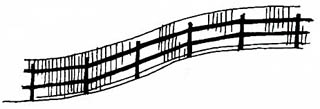
The fact is that the chapter keeps the shape when there is up to 6 degrees, which gives a bias 1:10, i.e. 1 m per 10 m. However, the mechanical properties of the Rabita at the same time are catastrophically fall, but in the fence on the outdoors it is insignificant, because Almost all operational loads take on supports with rigid strapping.
The team-section fence from the chain (pos. 4) of roads, time consuming and, by the way, less durable (the frame is lighter easier to demolish or cut out than to break the solid mesh cloth), and it is easier to overcome. Its only dignity is a more or less decent appearance and smaller dynamic loads on the grid, which is especially essential for a color plasticized chain, see below. One-piece sectional fences from the Rabita (pos. 5) are durable, difficult to surpose, visually visible, but roads, laborious and little maintainable. It is most often children's, sports and industrial sites, therefore, then one-piece sectional fences are not considered.
Note: If you are going to make a sectional fence from the grid, then the first thing you need to consider the option made of a welded flat grid. The slave in this performance before it does not have any advantages, but the welded grid is cheaper and easier is mounted.
Grid
Installation of the fence from the chain grid is possible not from any kind of her species, which are in the production and sale of dozens, if not hundreds. "Black" challenge from structural steel without coating (pos. 1 in Fig.) - Plastering and reinforcing grid, for outdoor use not intended: Quickly rust, does not keep painting, rather fragile and starts to break from the winds rather rather than it rushes.
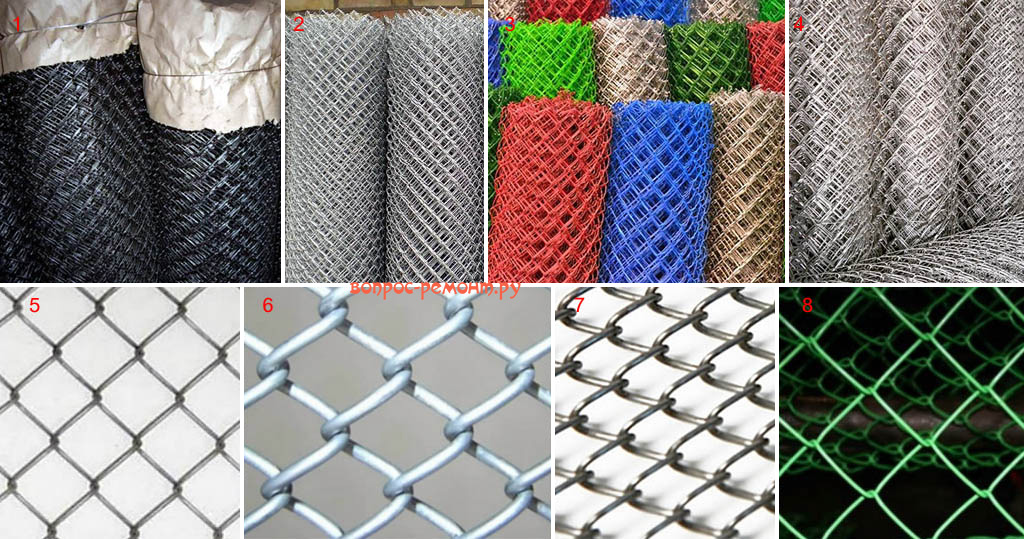
On the fences most often goes galvanized chain from the wire of high plasticity (pos. 2), t. Naz. Gray. She stands approx. 7-12% more expensive black. A cheerful fence can be made from a plasticized slave (with color PVC coating, pos. 3), but only a sectional one. A solid cloth of their color challenges under the wind is bent, plastic on the joints is wiped over the winter, and the grid rust. Very fast, because In this case, the metal eats a capillary moisture. There is a plasticized slaughterhouse somewhere 1.5 times more expensive gray.
Note: In wide sale there is still a chain chain stainless steel wire, pos. 4. Warrant fence dream, but, like all wonderful dreams, in real life is very expensive.
Ferry and wire
Fences are usually made from the challenge of vertical overlooking the cells of 50-60 mm, from the wire with a diameter of 1.6-2.2 mm, pos. 5. For the fence of the household with a bird, a more expensive mesh is needed with the cells are not larger than 30 mm, otherwise chickens will differ, and ferrets and caressing will not be possible to get into the poultry house. The lower gap of the fence (see below) in this case is closed with boards or slate.
The grid of increased wires from a thickness of up to 4-5 mm (pos. 6) is needed on a fence of a chamber or a bent for cattle. It is difficult to work with her, especially to split the panels (see below), because The strengthened chain chain and hard.
The variety of chains with fine, up to 20 mm, strongly fightened, so-called, is very strong and elastic. Pacitary mesh (pos. 7, remember the old beds?). But it is much more expensive than the usual fence chain, and it is even harder to work with her. Finally, a little suitable for fences with a solid cloth of a slave horizontal obstacle, pos. 8: Make a joke of her cloths in the fence is imperceptible.
Splicing and tension
The chain grid is produced by a width of 1.1 m rolls from 10 m. For fences, 10-meter rolls are usually purchased. 1,5-3 m wide. Raming large rolls without load-lifting mechanisms is impossible. Those., There will be several rolls on the fence, whose panels (if the fence is not sectional) you need to combine into one canvas.
Splicing the chain panels in the cloth wire (pos. 1 in Fig.), It is not necessary - ugly and indefinitely. For splicing, the slaughterhouses from the edge of one of them carefully dismiss one spiral (one obey) and it, oiling, soaked in 2 extremely obstrines, they sprinkle them, pos. 2.
Also, when installing the fence from the Rabenty, the grid must be stretched. Especially - if the tension is tensioning, then the grid must be stretched by the vague. In the methods for this, it is recommended to use the screw talpār (pos. 3) or tali, but with reservoir means and with 2 helpers can be caught and easier, pos. four:
- In extreme oblasts, the segments of reinforcement rods with a diameter of 10 mm are filled, and knitting a bridle from a textile or synthetic cable with a thickness of 12 mm.
- On the one hand, the ultawer is carried out on the hollow on the sub-standard 4a, throw onto the firmware "Boy" with faster-legend between him and the extreme post, and make a cable gate 4b, while not tightening it to Natogo.
- On the other hand, the pocket with the focus was put by the Kol-lever (VAGA) of 4V with another udis chosen on him.
- One worker holds a vaga vertically, holding a ultimate ultimate, so as not to slip, and the other wraps the gate as much as possible.
- The worker at the gate sticks it, and the worker on Vaga pulls her on himself. The grid will be stretched with an effort, approx. equal to the tale of 4 blocks.
- Workers keep the grid stretched, and the wizard creparates it.
Mounting mesh
The mesh is fixed to the extreme pillars, introducing the same reinforcements into its nearest from the inside. Then the rods in 4-5 places attract the columns to the clamps and, if necessary, additionally grab the bars (not the grid!) To the welding columns. The mesh is attached to the intermediate column and, thus, it turns out to be stretched out. Depending on the type of fence, the mesh fastening method can be different, see below.
Pillars
The fence poles from the chain can be wooden, steel from a round or profile pipe or round of asbetic pipe; In the latter case, reinforcement and concreting are required for piles. Available ready-made pillars for mesh fences with hooks (for stretched and mounted fences) or mounting paws (for sectional). It is necessary to plunge the pillars to the ground, not less than 80 cm, and better by 120 cm and deeper. Here the role plays no longer the depth of the freezing and frosty grounding of the soil, but the lateral operational loads on the pillar. The minimum sizes of the cross section of the pillars for the fence from the Rabitsa are:
- Pine or spruce for the fence with a cloth on the string - 100x100 mm.
- The same, oak or larch - 80x80 mm.
- Steel out of proftrube with a wall of 3 mm - 60x60 mm for the fence with a cloth on a string or sectional and 40x40 mm for others.
- Steel from a round tube with a wall of 2.5 mm - dia. 80 and 60 mm acc.
- Asbicated - diameter from 120 mm for a fence with a cloth on a string and from 100 mm for a mounted cloth.
Note: Sectional fences from the challenge on wooden and asbetic columns can not be done. Fences with mounted cloth on wooden poles to do is undesirable, because Poles in such structures are not tense previously. Asbotic fence posts are not maintainable.
Strengthening pillars in the ground is possible in the following ways (see Fig.):

- A bog or knocking - on dense not strongly bunted non-plated soils: dry loams and clays, grave and shrinkable soils;
- With partial concreting - in areas with a small depth of freezing on soils with a carrier capacity from 1.7 kg / sq. See practically - on any sustainable soil;
- Looking - recommended for wooden pillars on the soils as in the pre. P. Under the post, a sand-gravel pillow with a capacity of 20-30 cm is poured, boot poured in a layer, 15-20 cm, trambed and peckped with sand. Properly prepared wooden poles (see below) in such nests cost 50-70 years or more;
- Full concreting - in all other cases. Under the post - an anti-pillow, as in before. P; The solution from M150 is poured in layers, 10-15 cm. The next layer is poured as soon as before. Start capture. The pillar is fixed by temporary defickers at the time of set by concrete 50% strength (3-7 days).
How to cook wooden poles?
The fence from the chain on the wooden pillars can also be durable and reliable as on steel, if they are properly prepared. Maintainability of the fence on wooden columns above, because Consider or replace a broken wooden pillar easier than the rolled steel. Preparation of wooden pillars for the fence is as follows:
- Brux-blanks are impregnated with engine oil through or any oil biocide-hydrophobizer (water-pumping composition).
- Underground + OK. 50 cm above ground twice impregnate with bitumen mastic.
- Underground + OK. 30 cm. Overhead is referred to a rubberoid, tightening a thin soft wire wrap. It is impossible to mount nails or self-drawing!
- The upper end of the installed post is blamed with a densely oil paint (Surik, Oh, Belil), no matter whether the post will be separated somehow.
How to put fences?
The gap between the lower edge of the mesh and the ground in any fence from the slave is needed from 15-20 cm. Otherwise, the disadvantage is formed there, where pests and weeds will be obtained. To the cattle, trying to reach back to the freshell, did not wound the muzzle about the grid, and the bird did not run away, the lower gap is closed by boards or slate so that, if necessary, they can be removed.
On strings
Step-by-step instructions, how to establish the most common fence from the challenge on the 3rd strings, is given in Fig. The 3-string fence is very elated as an integer, therefore, in this case, the minor - frosty beamies are capable of spoiling such a fence only on strongly and overly bunched soils. From the pillars of the posts, they in this case hold each other with the help of tight strings. The minimum permissible diameters of steel wire and cable strings - 4 and 3 mm acc., But usually the strings take a 4-mm cable, and most often - 6 mm rod. You can still pull it on hand and, of course, it is stronger. This fence can be put without welding. Wire holders of the 1st type is hooked on the pillars scored by the hammer; 2nd type - self-tapping screws with hooks.
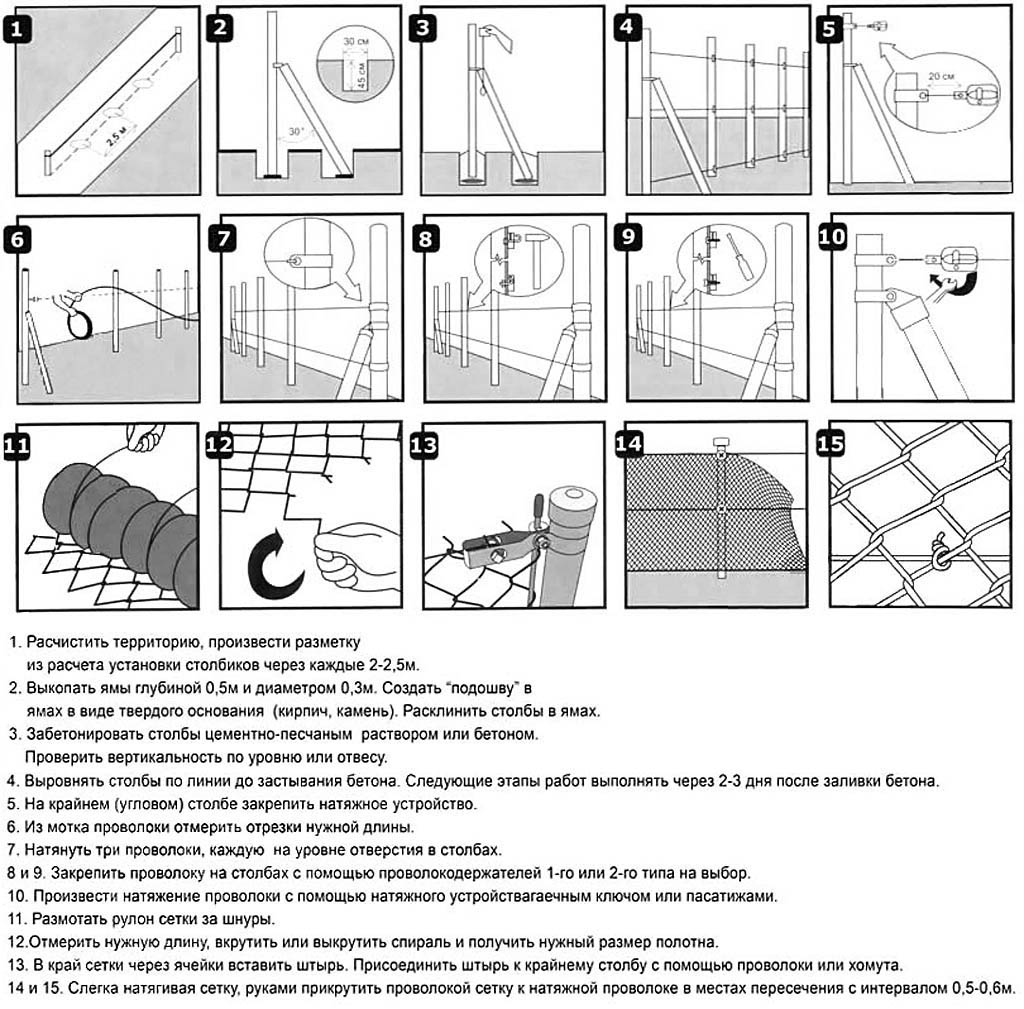
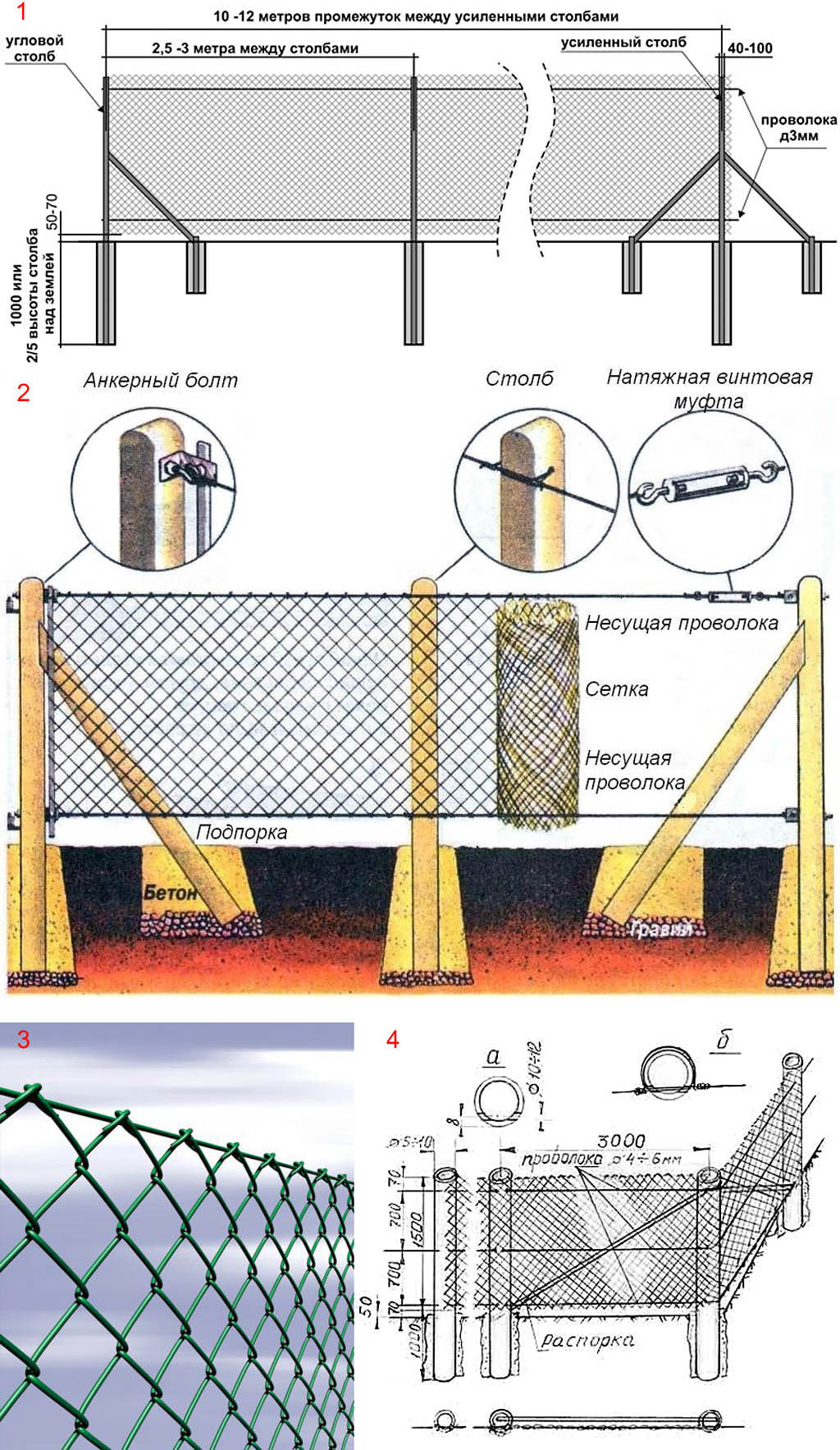
If the fence with the angles, then on the angular poles you need 2 pink under 90 degrees. And if the length of the fence from the angle to the angle exceeds 10-12 m, then on weak soils (soup, sand, black soil, gray and peat soils) are also necessary for intermediate poles, pos. 1 on the trail. Fig. Passion poles can in any case be without a subproof if the doorway is arched or with a crossbar. Also without subtacks of intermediate posts, a fence from the challenges on strips with wooden columns can be performed, pos. 2.
The grid on the strings is superimposed after their stretch. It is enough to grab the grid to the string "Usami" (pos. 3), because String plays with a grid. If the pillars are round, then the chain cloth can be circled without breaks (except for the gate and gate) throughout the perimeter, pos 4. Also, due to the greater strength of round bending pipes, in this case you can not concrete driven, but spread them between the columns.
Note: All abstractions from the rabs on strings can be performed without welding.
In the stray
The fence from the challenge on strings from the roda is the already transitional option to the fence with the mounted cloth. In the "real" attachments from the Rabita, the upper and lower strings are replaced with rigid reinforcing rods - by the lulls introduced into the mesh cells. Station are introduced into the ranks of the difference in advance as the rolls are unfolding. The top and bottom are attached to the pillars as well as vertical: throwing into hooks, clamps, welding. 2 options for installing fences from challenges with mounted cloth shown in video:
Installation of fences from grid Rabits (video)
And here we are limited to what you do not need to do, building such a fence.
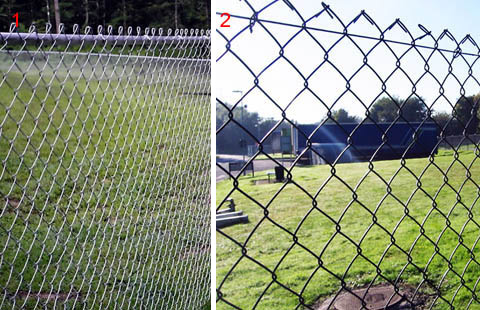
Firstly, the hard rod does not play along with the grid in the wind, so it is impossible to introduce it to the extreme rows of the difference (pos. 1 in Fig. Right), it is impossible to disperse. However, it is also impossible to introduce in 2-3 from the edge of the number of the Row (pos. 2), now for security reasons. The challenge when trying to climb through the fence from it in the alibar, not strongly and inexperienced or just a fence seems to be "to take" such a fence. But then he turns out to be hung on a wire, stupid in the stomach, and respond to other people's stupidity and evil up to prison is the owner. Therefore, the hinged fence is already inserted in 4-6 from the edge of the horizontal rows of the chain of the Rabita. Then it will simply be impossible to climb; As a last resort, absolutely unreasonable stubborn hands will cut, but do not gut yourself.
Note: Durable, more secure and fairly elegant fences from the challenges are obtained if we take a thin professional professional; Drawings of the span of such a fence, see fig. below. This is a transitional type to the cloth fence on the leather.
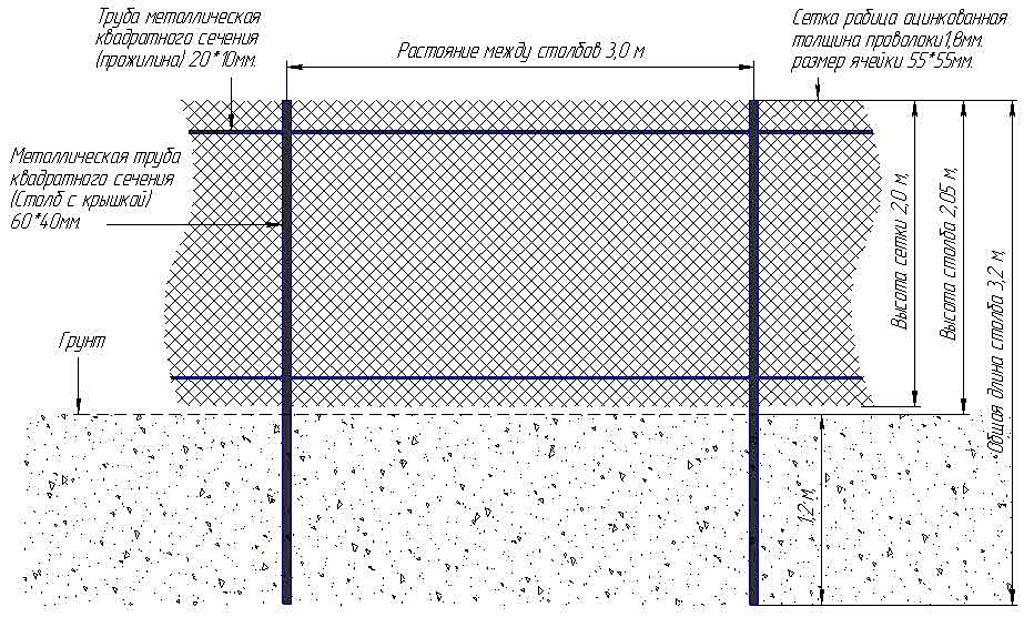
On leather
The device of the fence from the chain on wooden leavings is shown at the next rice; This fence is also possible to collect without welding. Poles do not need to take with paws; End to them can be mounted on wood screws, if wooden pillars, or metal, if steel poles. For the fence on the slope, this option is even preferable.

But this is why it is not necessary to simplify in the fence from the challenges on the outdoors, it is the method of fastening the grid. Here you need the same reinforcement bars that are nailed to running U-shaped brackets or curved nails. If you fix the grid as shown on the right in Fig., Or simply nails / self-pressing, then during the year it will lead, no matter how initially stretched.
Sectional
The sectional fence from the Rabita may have a look pretty looking, if the frames of the sections are welded from the proftrub, and the grid should be taken directly to them point welding; The drawing of the section of such a fence, see the left in fig. below. Collect sections with lying:
- Height frames are boiled than stretched in the width of the grid.
- Put the frame of the plafhmy.
- The segment of the length of the length is applied on the frame, the larger length of the span, and stretch with plug-in alms, as described above.
- Grab each number on the frame with point welding.
- Crop the surplus grid.
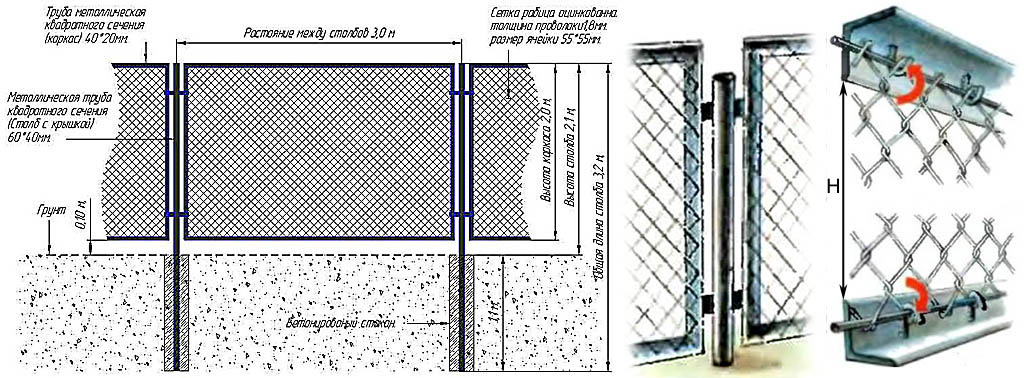
As you can see, it takes or special equipment, or at least 4 strong assistants, and still a point welding machine, and another part of the mesh is in the waste. Therefore, sectional fences from the challenge do it most often in the frames from the corner of 30x30x4 or 40x40x5 (right in Fig.):
- Rolled the grid for the length of the span and stretch along and across as far as possible. It is better to do it on Earth, fixing by the spicy. Insert stirred to the extreme rows of the carriage.
- The distance between the external edges is measured. The distances between the corners H addressed to each other should be equal to them.
- In the corners, mounting hooks from 6 mm rods, which are 1-1.5 cm to add to each other are 1-1.5 cm.
- When installing the fence, first pounce on the hooks upper alive (mesh must be hurt).
- Then 4 montizers (for which the assistant needed) is settled on the hooks lower alive.
- Similarly put lateral spaces.
Relief and Top
Instead of imprisonment, we suggest to see another roller, how to put fences from the challenges on slopes, irregularities and the furnace ground:
